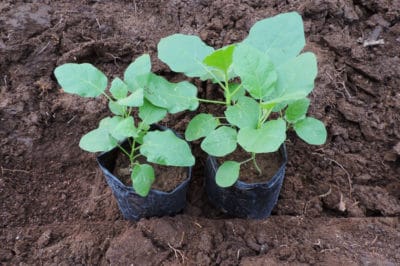Starting Your Eggplant
Give yourself plenty of time if you’re starting eggplants from seed. Your seedlings should be transplanted outdoors two to three weeks after the last frost, and they should be well established before transplanting. Start your seeds at least four weeks before the last frost date–six is even better.
You can also pick up seedlings at the local garden center. Look for plants that are short but leafy. Too-tall, yellowed, or “leggy” plants likely haven’t received enough sunlight, and are more susceptible to pests and disease.
Hardening Off
Because eggplants are sensitive to temperature changes, transplanting them straight from an indoor environment can cause stress on the plants. Instead, go through the process of “hardening off,” or acclimating your eggplants to the outdoor environment, before planting them directly. Leave the plants outdoors in a bright but sheltered area for a few days, making sure to water well. Gradually move the plants closer to the full exposure of the garden, and give them time to adapt before planting. If frost threatens, bring the plants indoors.
Soil
Choose an area in full sun for your eggplants. They prefer light, sandy soil with a slightly low (acidic) pH–work compost into the top six inches of soil before planting to encourage a bountiful harvest.
Planting
- Dig holes to receive your plants that are as deep as their current containers, twice as wide, and at least 18 inches apart.
- Gently remove the plants from their containers, taking care not to disturb the roots.
- Set the plants into the holes. If the soil level of the plant is below ground level, carefully lift it up and add soil to the bottom of the hole.
- Press the soil around your seedling firmly, removing any large air pockets.
- Water the soil thoroughly; avoid getting water on the leaves, as this promotes disease.
Your eggplants may wilt slightly after transplanting, but as their roots begin to take hold again, they’ll perk up in no time. By the end of the season, you’ll have plenty of eggplants for all your favorite recipes.
